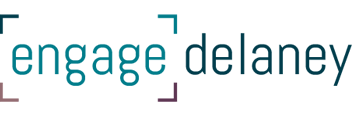Welcome to Delaney’s 12 Days of Christmas
Disclaimer: We’re not sending out Christmas cards this year. It’s not that we don’t want to wish colleagues, clients and collaborators a Merry Christmas – it’s just that we don’t want to add to your recycling bin. So, we’ve decided to do a special 12 Days of Christmas with our best tips, tricks, learnings and insights related to all things engagement. We thought this would be more helpful than a Christmas card to show you just how much we care about you and your engagements!
To kick things off, we thought we’d take stock of 2015 and share a few things that went well – and not so well – in our little world of engagement.
What worked well?
Traditional techniques: We picked up the phone for interviews, did engagements at lemonade stands, and facilitated focus groups. There was also usually an online component to our projects this year, but what worked well was connecting with real people where they were at.
Social media promotion: We are loving the results and metrics with social media promotions. We’ve been having good success with all the usual suspects (Facebook, Twitter, LinkedIn, and Hootsuite) and have used online promotion effectively for in-person events, as well as online engagement opportunities.
Integrated engagement planning: Whether it’s working with an advisory group, patients, or local stakeholders, it has never failed us to have stakeholders on a committee or the planning team when it comes to planning an engagement. We ask them:
- What’s going to engage you and your neighbours?
- What’s worked well in the past?
- What’s failed in the past?
- What would success look like for you?
- How do we get your mom, brother, and cynical friend to engage?
Bringing stakeholders into the design of an engagement process helps ground the entire process in stakeholder preferences. We always say, “It’s not about us, but about those who are impacted.”
What didn’t work so well?
Qualitative/Quantitative: We’ve designed and implemented engagement processes that were very qualitative in nature – for example, interviews, focus groups and workshops were held – and then been asked to produce reports that are highly quantifiable. What percentage of participants said that? What is the correlation between age and preferences for priorities? What we’ve learned is that we need to be very specific about how the engagement findings will be evaluated and reported because coding interview transcription can lead to excessive eating of chocolate, at late hours of the day.
Credentials for online engagement: A credential process is required for some of the platforms we’ve used for online engagement. This makes good sense because the engagement sponsor wants to know that real people are completing a survey, or participating in a discussion forum. The flip side is that this is a barrier for some people. They might be willing to complete an online survey, but not to create an account and provide demographic and geo-specific information. At first, we perceived that this was primarily for an older demographic, but the reality is that everyone is tired of getting their inbox full of “stuff” and they don’t want to sign up for anything that might lead to unwanted email.
Templates to support consistency: We’ve done lots of work with clients to develop customized templates, so that staff across a large organization can follow a consistent approach to engagement planning and design. The templates have worked well, but we are finding that sometimes staff want engagement to be “so, so easy” that they don’t want to read a lot, or work through a lot of content. So, the challenge is balancing completeness of process with staff capacity – particularly when engagement isn’t their full-time job.
So, what? Who cares about what worked well and what didn’t?
We do. It’s part of being reflective engagement specialists, and it ensures continuous learning and growth.
The end of the year is a good time to ask yourself:
- What has our organization done to engage our stakeholders, communities, clients, partners and staff effectively?
- What hasn’t worked so well?
- What can we learn from it?
- What can we do differently in 2016?
- How can we build engagement capacity in 2016?
Ask yourself, colleagues and stakeholders these questions and then document the answers. You might win the lottery and move on, but your organization will benefit from documenting the wins and acknowledging the challenges of your 2015 engagements. That way, you can set things up to get more of the good stuff and less of the other stuff in 2016.


